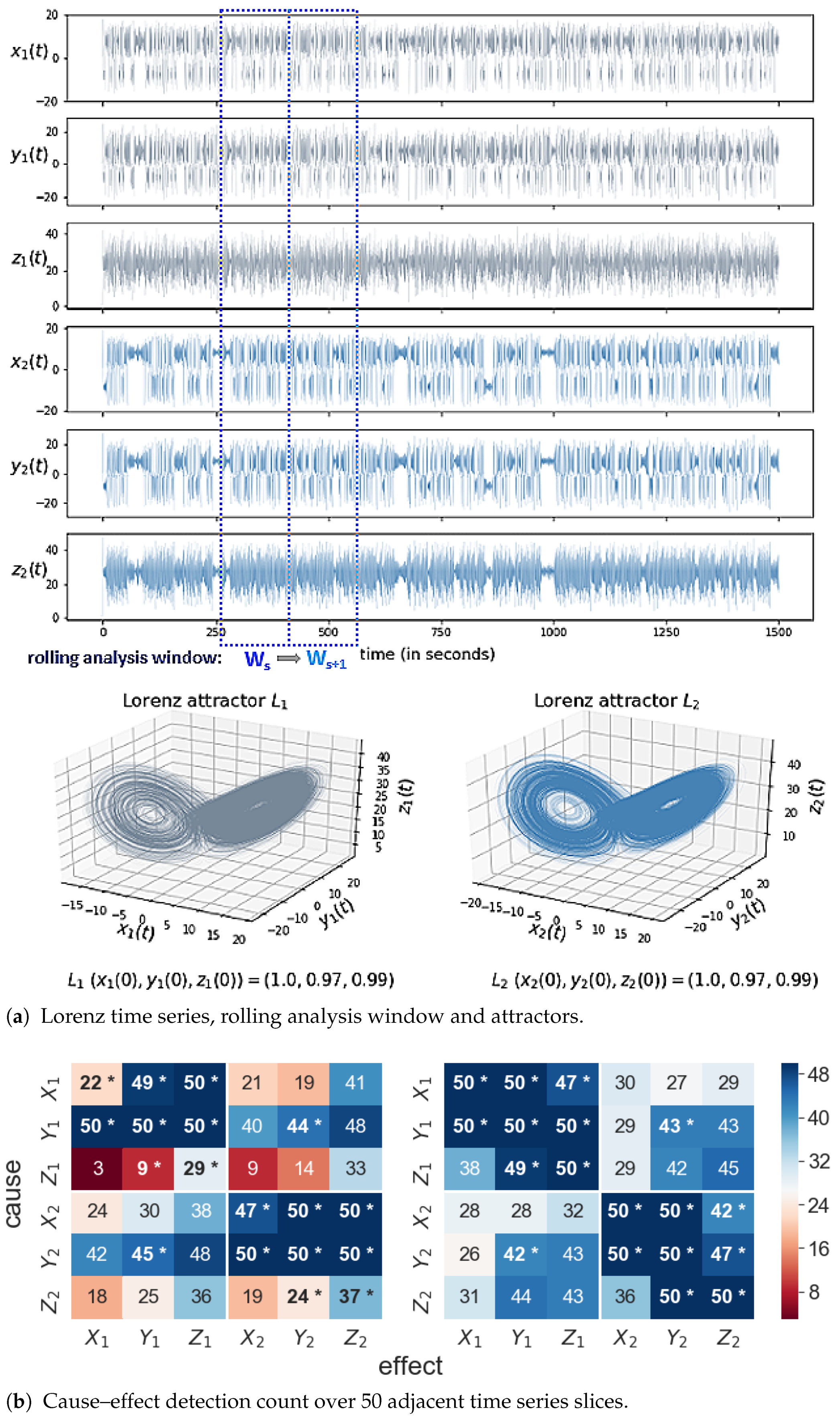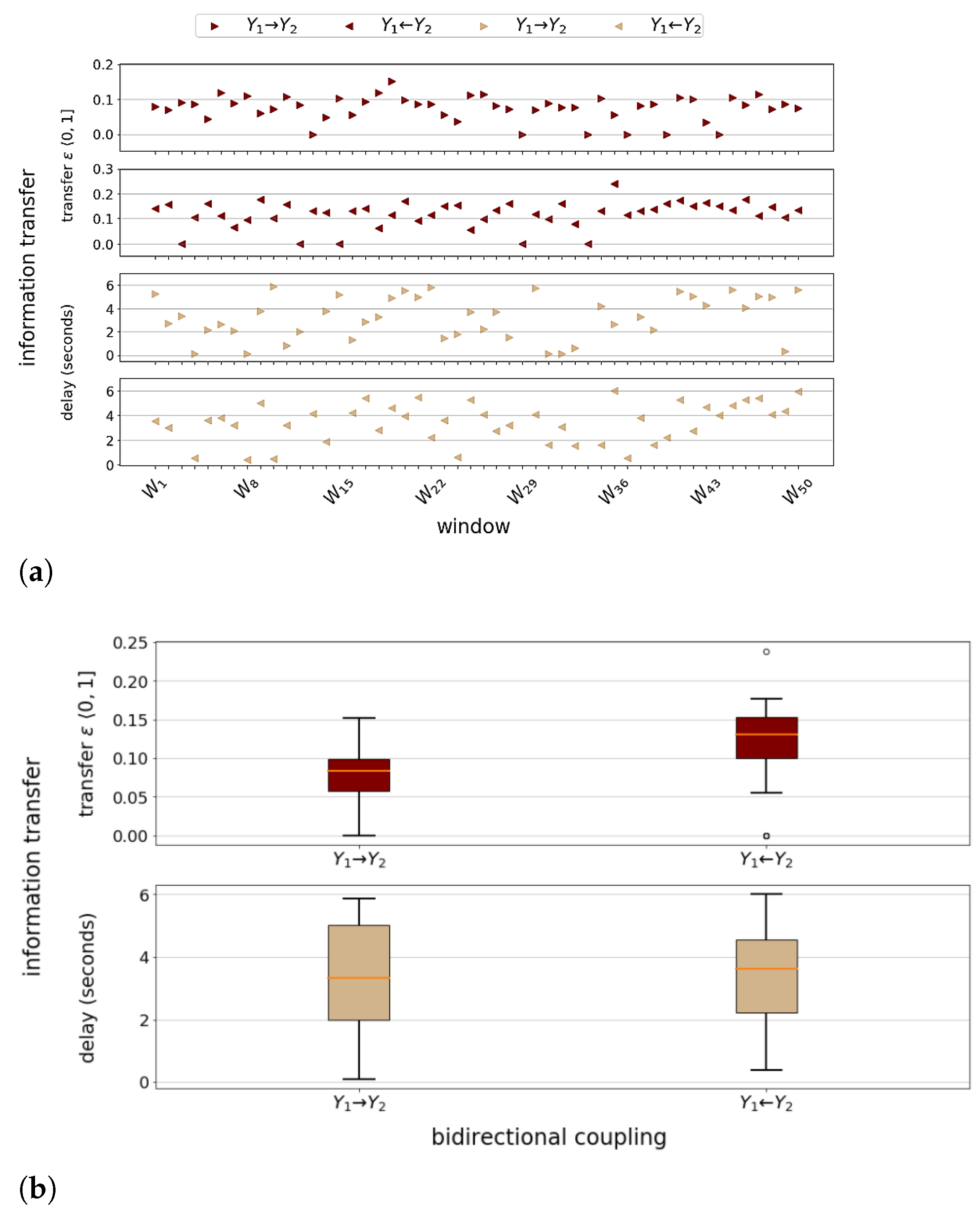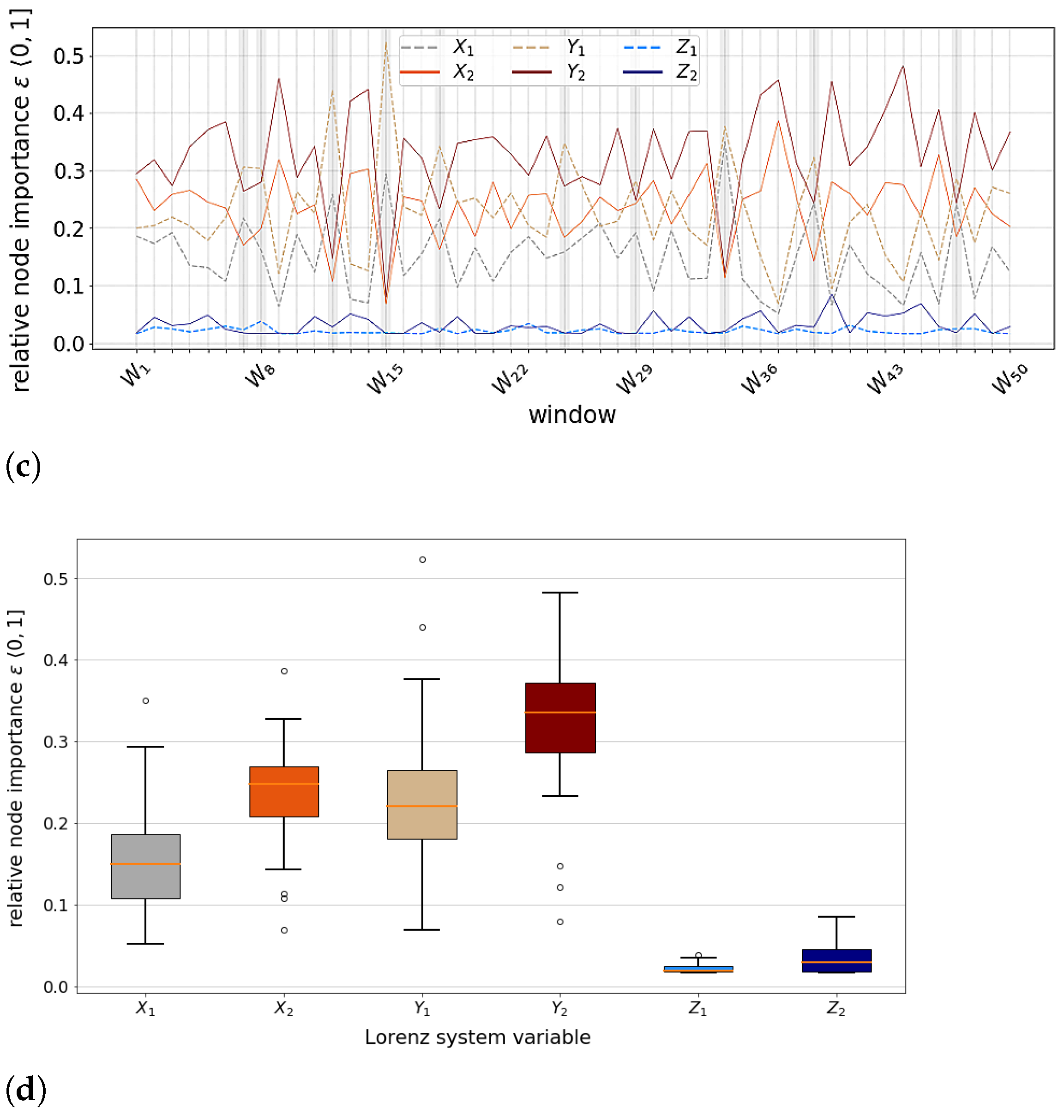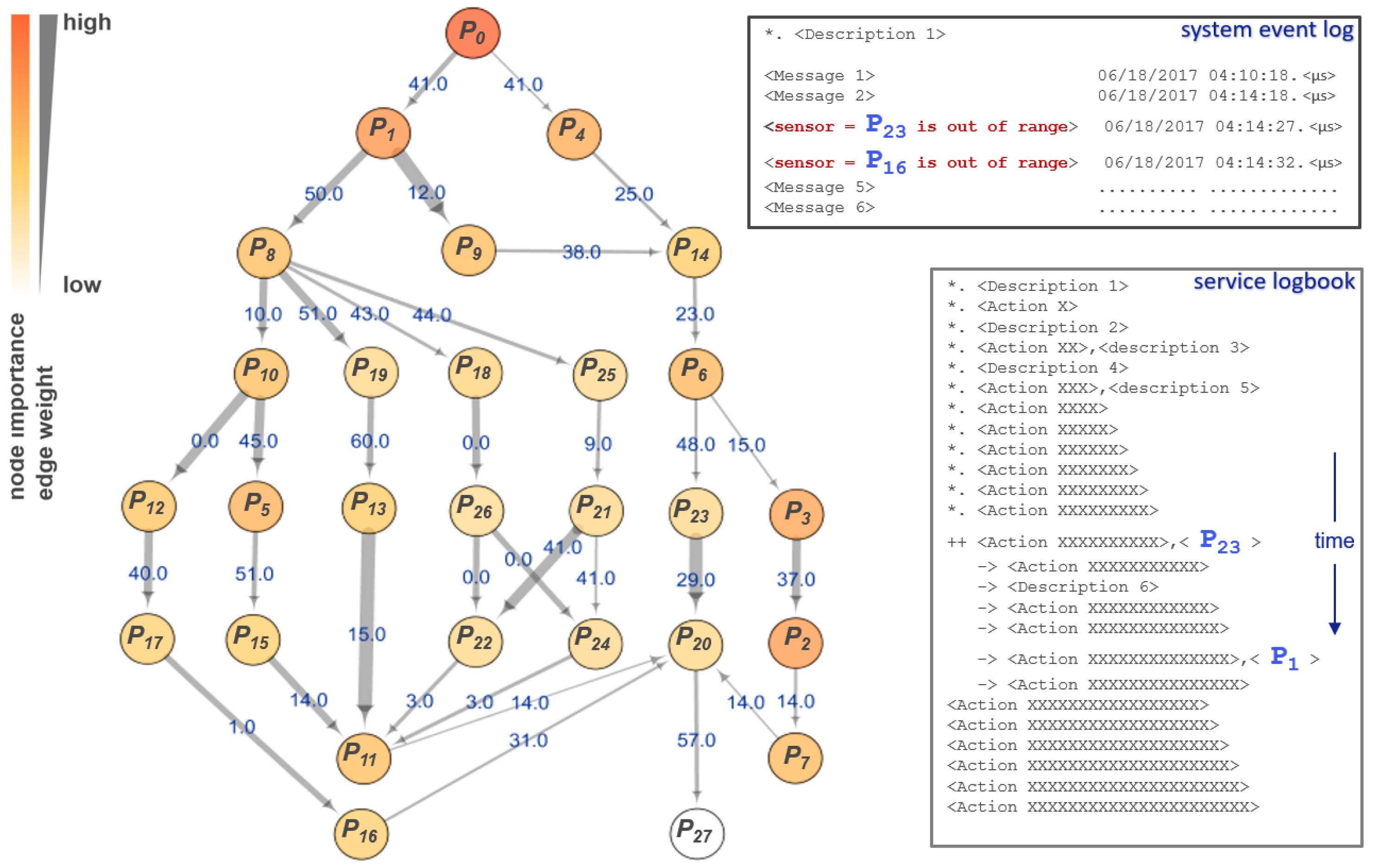Spectral Ranking of Causal Influence in Complex Systems
Abstract
1. Introduction
2. Applied Algorithms and Methods
2.1. Transfer Entropy
2.2. Eigenvector Centrality
| Algorithm 1 FaultMap. |
Information Transfer Network Inference
|
2.3. Validation
3. Results and Discussion
3.1. Coupled Lorenz Systems
3.2. Technological Complex Systems
4. Conclusions
Author Contributions
Funding
Data Availability Statement
Conflicts of Interest
References
- Schreiber, T. Measuring Information Transfer. Phys. Rev. Lett. 2000, 85, 461–464. [Google Scholar] [CrossRef] [PubMed]
- Bonacich, P. Factoring and weighting approaches to status scores and clique identification. J. Math. Sociol. 1972, 2, 113–120. [Google Scholar] [CrossRef]
- Barnett, L.; Barrett, A.B.; Seth, A.K. Granger Causality and Transfer Entropy Are Equivalent for Gaussian Variables. Phys. Rev. Lett. 2009, 103, 238701. [Google Scholar] [CrossRef] [PubMed]
- Lizier, J.; Rubinov, M. Multivariate construction of effective computational networks from observational data, Preprint 25/2012. In Max Planck Institute for Mathematics in the Science; 2012; Available online: http://www.mis.mpg.de/preprints/2012/preprint2012_25.pdf (accessed on 14 April 2014).
- Benzi, M.; Klymko, C. On the Limiting Behavior of Parameter-Dependent Network Centrality Measures. SIAM J. Matrix Anal. Appl. 2015, 36, 686–706. [Google Scholar] [CrossRef]
- Katz, L. A new status index derived from sociometric analysis. Psychometrika 1953, 18, 39–43. [Google Scholar] [CrossRef]
- Kalavri, V.; Simas, T.; Logothetis, D. The shortest path is not always a straight line: Leveraging semimetricity in graph analysis. Proc. VLDB Endow. 2016, 9, 672–683. [Google Scholar] [CrossRef]
- Streicher, S.; Sandrock, C. Plant-wide fault and disturbance screening using combined transfer entropy and eigenvector centrality analysis. arXiv 2019, arXiv:1904.04035. [Google Scholar]
- Wiener, N. The theory of prediction. In Modern Mathematics for the Engineer; Beckenbach, E.F., Ed.; McGraw-Hill: New York, NY, USA, 1956. [Google Scholar]
- Schreiber, T.; Schmitz, A. Surrogate time series. Phys. Nonlinear Phenom. 2000, 142, 346–382. [Google Scholar] [CrossRef]
- Page, L.; Brin, S.; Motwani, R.; Winograd, T. The PageRank Citation Ranking: Bringing Order to the Web; Technical Report; Stanford Digital Libraries: Stanford, CA, USA, 1998; pp. 1–17. [Google Scholar]
- Frobenius, G. Ueber Matrizen aus nicht negativen Elementen. Sitzungsberichte KöNiglich Preuss. Akad. Wiss. 1912, 26, 456–477. [Google Scholar]
- Perron, O. Zur theorie der matrices. Math. Ann. 1907, 2, 248–263. [Google Scholar] [CrossRef]
- Wills, R.S. Google’s PageRank: The Math Behind the Search Engine. Math. Intell. 2006, 28, 6–11. [Google Scholar] [CrossRef]
- von Mises, R.; Pollaczek-Geiringer, H. Praktische Verfahren der Gleichungsauflösung. ZAMM Z. Angew. Math. Mech. 1929, 9, 152–164. [Google Scholar] [CrossRef]
- Wibral, M.; Wollstadt, P.; Meyer, U.; Pampu, N.; Priesemann, V.; Vicente, R. Revisiting Wiener’s principle of causality–interaction-delay reconstruction using transfer entropy and multivariate analysis on delay-weighted graphs. In Proceedings of the 2012 Annual International Conference of the IEEE Engineering in Medicine and Biology Society, San Diego, CA, USA, 28 August–1 September 2012; pp. 3676–3679. [Google Scholar]
- Flunkert, V. Pydelay: A Simulation Package, Delay-Coupled Complex Systems and Applications to Lasers; Springer: Berlin/Heidelberg, Germany, 2011. [Google Scholar]
- Runge, J. Causal Network Reconstruction from Time Series: From Theoretical Assumptions to Practical Estimation. Chaos Interdiscip. J. Nonlinear Sci. 2018, 28, 075310. [Google Scholar] [CrossRef] [PubMed]
- Lizier, J.T. JIDT: An Information-Theoretic Toolkit for Studying the Dynamics of Complex Systems. Front. Robot. AI 2014, 1, 1–11. [Google Scholar] [CrossRef]
- Bauer, M. Data-Driven Methods for Process Analysis. Ph.D. Thesis, University of London, London, UK, 2005. [Google Scholar]
- Krich, C.; Runge, J.; Miralles, D.G.; Migliavacca, M.; Perez-Priego, O.; El-Madany, T.; Carrara, A.; Mahecha, M.D. Estimating causal networks in biosphere–atmosphere interaction with the PCMCI approach. Biogeosciences 2020, 17, 1033–1061. [Google Scholar] [CrossRef]
- Gencaga, D.; Rossow, W.; Knuth, K. A Recipe for the Estimation of Information Flow in a Dynamical System. Entropy 2015, 17, 438–470. [Google Scholar] [CrossRef]
- Coufal, D.; Jakubík, J.; Jajcay, N.; Hlinka1, J.; Krakovská, A.; Paluš, M. Detection of coupling delay: A problem not yet solved. Chaos 2017, 27, 083109. [Google Scholar] [CrossRef] [PubMed]
- Rayleigh, L. On convecting currents in a horizontal layer of fluid when the higher temperature is on the under side. Philos. Mag. 1916, 32, 529–546. [Google Scholar] [CrossRef]





Publisher’s Note: MDPI stays neutral with regard to jurisdictional claims in published maps and institutional affiliations. |
© 2021 by the authors. Licensee MDPI, Basel, Switzerland. This article is an open access article distributed under the terms and conditions of the Creative Commons Attribution (CC BY) license (http://creativecommons.org/licenses/by/4.0/).
Share and Cite
Zalmijn, E.; Heskes, T.; Claassen, T. Spectral Ranking of Causal Influence in Complex Systems. Entropy 2021, 23, 369. https://doi.org/10.3390/e23030369
Zalmijn E, Heskes T, Claassen T. Spectral Ranking of Causal Influence in Complex Systems. Entropy. 2021; 23(3):369. https://doi.org/10.3390/e23030369
Chicago/Turabian StyleZalmijn, Errol, Tom Heskes, and Tom Claassen. 2021. "Spectral Ranking of Causal Influence in Complex Systems" Entropy 23, no. 3: 369. https://doi.org/10.3390/e23030369
APA StyleZalmijn, E., Heskes, T., & Claassen, T. (2021). Spectral Ranking of Causal Influence in Complex Systems. Entropy, 23(3), 369. https://doi.org/10.3390/e23030369





